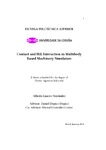Mostrar o rexistro simple do ítem
Contact and HiL interaction in multibody based machinery simulators
| dc.contributor.advisor | Dopico Dopico, Daniel | |
| dc.contributor.advisor | González Castro, Manuel Jesús | |
| dc.contributor.author | Luaces, Alberto | |
| dc.contributor.other | Universidade da Coruña. Departamento de Enxeñaría Industrial II | es_ES |
| dc.date.accessioned | 2013-08-14T10:37:47Z | |
| dc.date.available | 2013-08-14T10:37:47Z | |
| dc.date.issued | 2013 | |
| dc.identifier.uri | http://hdl.handle.net/2183/10130 | |
| dc.description.abstract | [Abstract] Multibody simulators allow to predict and evaluate the motion of machines and mechanisms under the action of the user and the interaction with the simulated environment. Interactive simulators guided by a human or a piece of hardware must be efficient enough to compute the state of the system in real time. ?erefore, employing fast and sufficiently accurate techniques is a must. In this work, generic tools for the implementation of this kind of simulators are provided. Efficient multibody formulations are reviewed for implementing real-time simulators. ?e index-3 Augmented Lagrange formulation with projections of velocities and accelerations is selected, due to its efficiency and stability. ?e integration of the equations of motion follows the Generalized-a method, which provides high-frequency dissipation, and can be unconditionally stable and secondorder accurate if suitable integrator parameters are chosen. Contact modeling and detection is essential for computing the interaction among the mechanisms and the simulated environment. Normal and tangential contact force models are presented. For the normal contact, a Hertz-type Hunt- Crossley model is chosen. ?e tangential force model is based on Coulomb’s law, and includes stiction and viscous friction effects. Both models were compared with the output of the Bowden-Leben stick-slip experiment. A real-time, simplified terrain model featuring digging forces for excavator simulators is also discussed. Several techniques are shown for detecting colliding bodies at run-time. ?e collision detection process is divided into two stages. ?e first one is a broad range and coarse grained process, where potentially colliding pairs of objects are discovered. Spatial and hierarchical division techniques as Octrees, BSP-trees and Directed Acyclic Graphs are presented for this purpose. In the second stage, fine-detailed contact properties are computed from each pair of bodies. Several models are presented for testing object enclosing volumes or more complex surfaces discretized as triangular meshes. State-of-the-art, Commercial Off ?e Shelf hardware devices are presented as the physical foundation of a simulator. Industrial-quality controllers, projection screens and audio devices are reviewed for this purpose. ?e implementation details for the use of those devices are also considered. Network communication procedures between the simulator and monitoring nodes are discussed, too. Finally, a particular implementation of all the techniques described in previous chapters is presented in the form of an interactive excavator simulator, which features all the degrees of freedom of the machine, and is able to perform earthmoving operations in a realistic environment. Monitoring capabilities are also available, and any training session can be defined by user scripts. ?e techniques described in this document constitute a generic and efficient compendium of algorithms that are well-fi?ed for medium or low-end computational systems, as desktop or even laptop computers. | es_ES |
| dc.language.iso | eng | es_ES |
| dc.rights | Os titulares dos dereitos de propiedade intelectual autorizan a visualización do contido desta tese a través de Internet, así como a súa reproducción, gravación en soporte informático ou impresión para o seu uso privado e/ou con fins de estudo e de investigación. En nengún caso se permite o uso lucrativo deste documento. Estos dereitos afectan tanto ó resumo da tese como o seu contido Los titulares de los derechos de propiedad intelectual autorizan la visualización del contenido de esta tesis a través de Internet, así como su repoducción, grabación en soporte informático o impresión para su uso privado o con fines de investigación. En ningún caso se permite el uso lucrativo de este documento. Estos derechos afectan tanto al resumen de la tesis como a su contenido | es_ES |
| dc.subject | Máquinas | es_ES |
| dc.subject | Métodos de simulación | es_ES |
| dc.title | Contact and HiL interaction in multibody based machinery simulators | es_ES |
| dc.type | info:eu-repo/semantics/doctoralThesis | es_ES |
| dc.rights.access | info:eu-repo/semantics/openAccess | es_ES |
Ficheiros no ítem
Este ítem aparece na(s) seguinte(s) colección(s)
-
Teses de doutoramento [2122]






